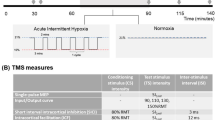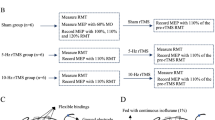Abstract
Acute mountain sickness is a common discomfort experienced by unacclimatized persons on ascent to high altitude. We tested the hypothesis that exposure to high altitude affects cortical excitability using transcranial magnetic stimulation. We specifically analyzed the motor cortex excitability in normal subjects at high altitude and in a control condition near sea level. Mean resting motor threshold (RMT) was significantly higher at high altitude than at sea level (69.3 ± 10.4 versus 56.3 ± 10.9%; P = 0.042). Mean short intracortical inhibition (SICI) was significantly lower at high altitude than at sea level (percentage of test motor-evoked potential = 79.3 ± 19.8 versus 28.7 ± 17.5%; P = 0.0004). Symptoms of acute mountain sickness correlated with resting motor threshold changes induced by high altitude (R 2 = 0.53, P = 0.037). SaO2 correlated with SICI changes induced by high altitude (R 2 = 0.45, P = 0.036). We suggest that high altitude deeply changes cortical excitability by affecting both inhibitory and excitatory circuits and that this is reflected in acute mountain sickness symptoms.


Similar content being viewed by others
References
Bloom FE, Landis SC, Roberts JL, Squire LR (1999) Fundamental neuroscience, Chapt 26. San Diego Academic, San Diego, pp 761–789
Bruehl C, Witte OW (2003) Relation between bicarbonate concentration and voltage dependence of sodium currents in freshly isolated CA1 neurons of the rat. J Neurophysiol 89(5):2489–2498
Cummins TR, Jiang C, Haddad GG (1993) Human neocortical excitability is decreased during anoxia via sodium channel modulation. J Clin Invest 91(2):608–615
Di Lazzaro V, Oliviero A, Meglio M, Cioni B, Tamburrini G, Tonali P, Rothwell JC (2000) Direct demonstration of the effect of lorazepam on the excitability of the human motor cortex. Clin Neurophysiol 111(5):794–799
Fulco CS, Rock PB, Trad L, Forte V Jr, Cymerman A (1988) Maximal cardiorespiratory responses to one- and two-legged cycling during acute and long-term exposure to 4,300 meters altitude. Eur J Appl Physiol Occup Physiol 57(6):761–766
Gallagher SA, Hackett PH (2004) High-altitude illness. Emerg Med Clin North Am 22(2):329–355
Grocott MP, Martin DS, Levett DZ, McMorrow R, Windsor J, Montgomery HE, Caudwell Xtreme Everest Research Group (2009) Arterial blood gases and oxygen content in climbers on Mount Everest. N Engl J Med 360(2):140–149
Gu XQ, Yao H, Haddad GG (2000) Effect of extracellular HCO(3)(−) on Na(+) channel characteristics in hippocampal CA1 neurons. J Neurophysiol 84(5):2477–2483
Hallett M (2000) Transcranial magnetic stimulation and the human brain. Nature 406:147–150
Kujirai T, Caramia MD, Rothwell JC, Day BL, Thompson PD, Ferbert A, Wroe S, Asselman P, Marsden CD (1993) Corticocortical inhibition in human motor cortex. J Physiol 471:501–519
Leaf DE, Goldfarb DS (2007) Mechanisms of action of acetazolamide in the prophylaxis and treatment of acute mountain sickness. J Appl Physiol 102(4):1313–1322
Mackert BM, Staub F, Peters J, Baethmann A, Kempski O (1996) Anoxia in vitro does not induce neuronal swelling or death. J Neurol Sci 139(1):39–47
Miyamoto O, Auer RN (2000) Hypoxia, hyperoxia, ischemia and brain necrosis. Neurology 54:362–371
Mohamed-Hussein AA, Hamed SA, Abdel-Hakim N (2007) Cerebral cortical dysfunction in chronic obstructive pulmonary disease: role of transcranial magnetic stimulation. Int J Tuberc Lung Dis 11(5):515–521
Oliviero A, Corbo G, Tonali PA, Pilato F, Saturno E, Dileone M, Versace V, Valente S, Di Lazzaro V (2002) Functional involvement of central nervous system in acute exacerbation of chronic obstructive pulmonary disease: a preliminary transcranial magnetic stimulation study. J Neurol 249(9):1232–1236
Orth M, Rothwell JC (2004) The cortical silent period: intrinsic variability and relation to the waveform of the transcranial magnetic stimulation pulse. Clin Neurophysiol 115(5):1076–1082
Pearigen P, Gwinn R, Simon RP (1996) The effects of in vivo hypoxia on brain injury. Brain Res 725:184–191
Roach RC, Bärtsch P, Oelz O, Hackett PH, Lake Louise AMS, Scoring Consensus Committee (1993) The Lake Louise acute mountain sickness scoring system. In: Sutton JR, Houston CS, Coates G (eds) Hypoxia and molecular medicine. Queen City Printers, Burlington, pp 272–274
Szubski C, Burtscher M, Löscher WN (2006) The effects of short-term hypoxia on motor cortex excitability and neuromuscular activation. J Appl Physiol 101(6):1673–1677
Virués-Ortega J, Buela-Casal G, Garrido E, Alcázar B (2004) Neuropsychological functioning associated with high-altitude exposure. Neuropsychol Rev 14(4):197–224
Werhahn KJ, Kunesch E, Noachtar S, Benecke R, Classen J (1999) Differential effects on motorcortical inhibition induced by blockade of GABA uptake in humans. J Physiol 517(Pt 2):591–597
Wilson MH, Newman S, Imray CH (2009) The cerebral effects of ascent to high altitudes. Lancet Neurol 8(2):175–191
Ziemann U (2004) TMS and drugs. Clin Neurophysiol 115(8):1717–1729
Ziemann U, Lonnecker S, Steinhoff BJ, Paulus W (1996) Effects of antiepileptic drugs on motor cortex excitability in humans: a transcranial magnetic stimulation study. Ann Neurol 40(3):367–378
Ziemann U, Chen R, Cohen LG, Hallett M (1998) Dextromethorphan decreases the excitability of the human motor cortex. Neurology 51:1320–1324
Aknowledgment
This work was partially sponsored by the “FISCAM”, Junta de Comunidades de Castilla La Mancha (Spain).
Author information
Authors and Affiliations
Corresponding author
Additional information
G. Miscio sadly died in autumn 2007.
Rights and permissions
About this article
Cite this article
Miscio, G., Milano, E., Aguilar, J. et al. Functional involvement of central nervous system at high altitude. Exp Brain Res 194, 157–162 (2009). https://doi.org/10.1007/s00221-009-1729-1
Received:
Accepted:
Published:
Issue Date:
DOI: https://doi.org/10.1007/s00221-009-1729-1




